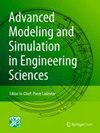A hybrid twin based on machine learning enhanced reduced order model for real-time simulation of magnetic bearings
IF 3.2
Q3 MECHANICS
Advanced Modeling and Simulation in Engineering Sciences
Pub Date : 2024-02-03
DOI:10.1186/s40323-024-00258-2
引用次数: 0
Abstract
The simulation of magnetic bearings involves highly non-linear physics, with high dependency on the input variation. Moreover, such a simulation is time consuming and can’t run, within realistic computation time for control purposes, when using classical computation methods. On the other hand, classical model reduction techniques fail to achieve the required precision within the allowed computation window. To address this complexity, this work proposes a combination of physics-based computing methods, model reduction techniques and machine learning algorithms, to tackle the requirements. The physical model used to represent the magnetic bearing is the classical Cauer Ladder Network method, while the model reduction technique is applied on the error of the physical model’s solution. Later on, in the latent space a machine learning algorithm is used to predict the evolution of the correction in the latent space. The results show an improvement of the solution without scarifying the computation time. The solution is computed in almost real-time (few milliseconds), and compared to the finite element reference solution.基于机器学习增强型减阶模型的混合孪生系统,用于磁悬浮轴承的实时仿真
磁悬浮轴承的模拟涉及高度非线性物理,对输入变化有很高的依赖性。此外,这种模拟非常耗时,使用传统计算方法无法在实际计算时间内完成控制目的。另一方面,经典的模型缩减技术无法在允许的计算窗口内达到所需的精度。为了解决这一复杂问题,这项工作提出了一种基于物理的计算方法、模型还原技术和机器学习算法的组合,以满足要求。用于表示磁轴承的物理模型是经典的考尔梯形网络法,而模型还原技术则应用于物理模型解的误差。随后,在潜空间中使用机器学习算法来预测修正在潜空间中的演变。结果表明,在不增加计算时间的情况下,解法得到了改进。解法几乎是实时计算的(几毫秒),并与有限元参考解法进行了比较。
本文章由计算机程序翻译,如有差异,请以英文原文为准。
求助全文
约1分钟内获得全文
求助全文
来源期刊

Advanced Modeling and Simulation in Engineering Sciences
Engineering-Engineering (miscellaneous)
CiteScore
6.80
自引率
0.00%
发文量
22
审稿时长
30 weeks
期刊介绍:
The research topics addressed by Advanced Modeling and Simulation in Engineering Sciences (AMSES) cover the vast domain of the advanced modeling and simulation of materials, processes and structures governed by the laws of mechanics. The emphasis is on advanced and innovative modeling approaches and numerical strategies. The main objective is to describe the actual physics of large mechanical systems with complicated geometries as accurately as possible using complex, highly nonlinear and coupled multiphysics and multiscale models, and then to carry out simulations with these complex models as rapidly as possible. In other words, this research revolves around efficient numerical modeling along with model verification and validation. Therefore, the corresponding papers deal with advanced modeling and simulation, efficient optimization, inverse analysis, data-driven computation and simulation-based control. These challenging issues require multidisciplinary efforts – particularly in modeling, numerical analysis and computer science – which are treated in this journal.
 求助内容:
求助内容: 应助结果提醒方式:
应助结果提醒方式:


